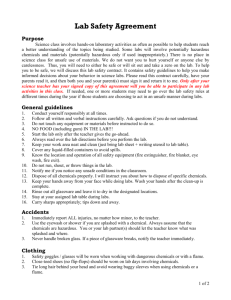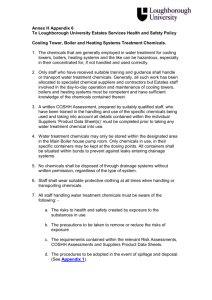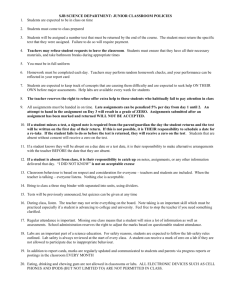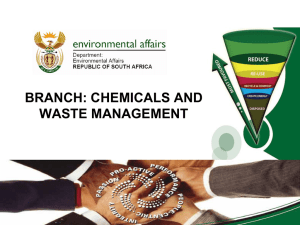Kaiser Permanente Comprehensive Chemicals Policy
advertisement
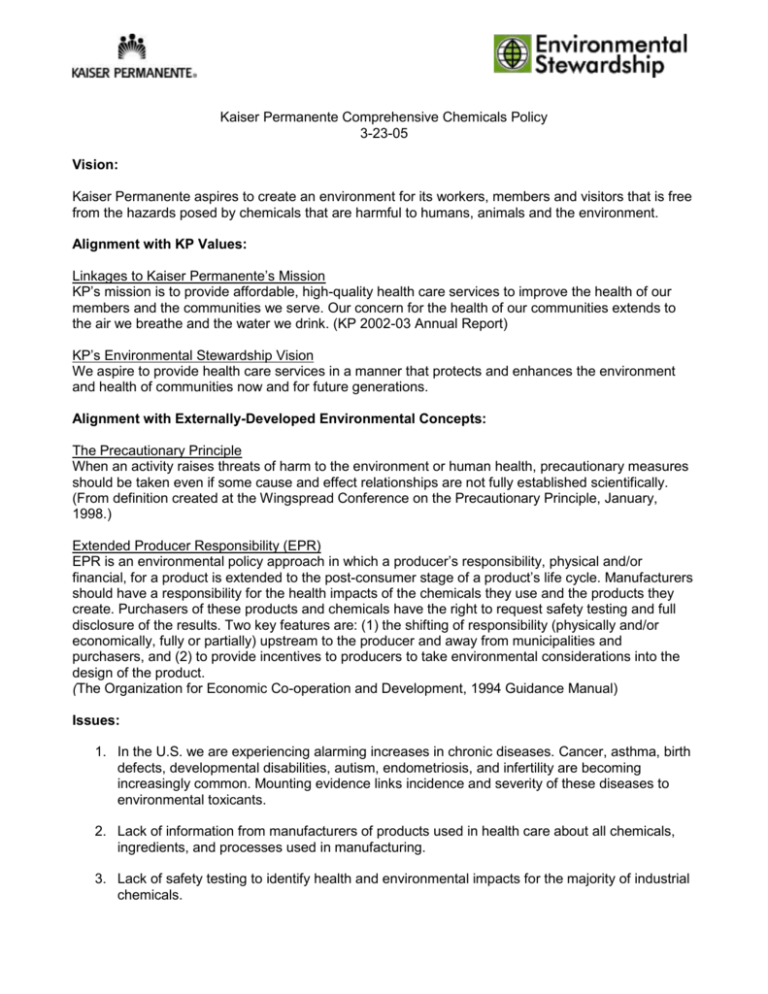
Kaiser Permanente Comprehensive Chemicals Policy 3-23-05 Vision: Kaiser Permanente aspires to create an environment for its workers, members and visitors that is free from the hazards posed by chemicals that are harmful to humans, animals and the environment. Alignment with KP Values: Linkages to Kaiser Permanente’s Mission KP’s mission is to provide affordable, high-quality health care services to improve the health of our members and the communities we serve. Our concern for the health of our communities extends to the air we breathe and the water we drink. (KP 2002-03 Annual Report) KP’s Environmental Stewardship Vision We aspire to provide health care services in a manner that protects and enhances the environment and health of communities now and for future generations. Alignment with Externally-Developed Environmental Concepts: The Precautionary Principle When an activity raises threats of harm to the environment or human health, precautionary measures should be taken even if some cause and effect relationships are not fully established scientifically. (From definition created at the Wingspread Conference on the Precautionary Principle, January, 1998.) Extended Producer Responsibility (EPR) EPR is an environmental policy approach in which a producer’s responsibility, physical and/or financial, for a product is extended to the post-consumer stage of a product’s life cycle. Manufacturers should have a responsibility for the health impacts of the chemicals they use and the products they create. Purchasers of these products and chemicals have the right to request safety testing and full disclosure of the results. Two key features are: (1) the shifting of responsibility (physically and/or economically, fully or partially) upstream to the producer and away from municipalities and purchasers, and (2) to provide incentives to producers to take environmental considerations into the design of the product. (The Organization for Economic Co-operation and Development, 1994 Guidance Manual) Issues: 1. In the U.S. we are experiencing alarming increases in chronic diseases. Cancer, asthma, birth defects, developmental disabilities, autism, endometriosis, and infertility are becoming increasingly common. Mounting evidence links incidence and severity of these diseases to environmental toxicants. 2. Lack of information from manufacturers of products used in health care about all chemicals, ingredients, and processes used in manufacturing. 3. Lack of safety testing to identify health and environmental impacts for the majority of industrial chemicals. 4. Burdens faced by users (KP) due to the lack of information: -ascertaining potential health impacts of products -conducting assessments of products (resources, expertise, data) -public concern -research work and testing required of purchasers that want to ensure products and -chemicals are safe -making product selection decisions without adequate information -continued use of potentially hazardous materials -potential liability -unpredictable regulatory climate -costs to organizations due to above listed burdens 5. Underclassification or mischaracterization of hazardous compounds. Actions: We will take the following actions to achieve our vision: Internal focus Identify high priority chemicals and chemical groups; regularly update and prioritize this data resulting in a living list of chemicals of concern Conduct an inventory of product standards for presence of chemicals of concern Understand cost implications of substitutions and incorporate cost of ownership model into purchasing systems Communicate preferences to GPO, vendors and manufacturers When appropriate, communicate desired alternatives and reasons to employees, members and the communities we serve Continue to pursue green building activities Develop goals and metrics to measure progress and include mechanisms for sharing successes and lessons with the public Contracting focus Create appropriate contractual obligations with manufacturers, suppliers and distributors to: avoid identified chemicals of concern conduct and share results of extended toxicity testing disclose processes that use chemicals of concern even if the chemicals used in the processes are not a part of the end product Substitute safer alternatives identified through hazard analysis Integrate a cost-of-ownership approach to assessing alternative products External focus Support sound public policies that promote greater evaluation of chemicals and public disclosure Influence manufacturers to provide materials disclosure and performance of safety tests Promote labeling of products with all ingredients Influence medical research into less hazardous clinical and laboratory products and processes



